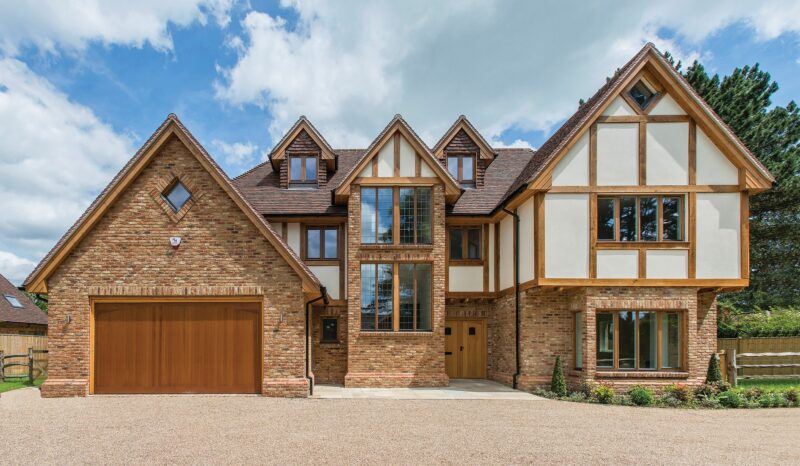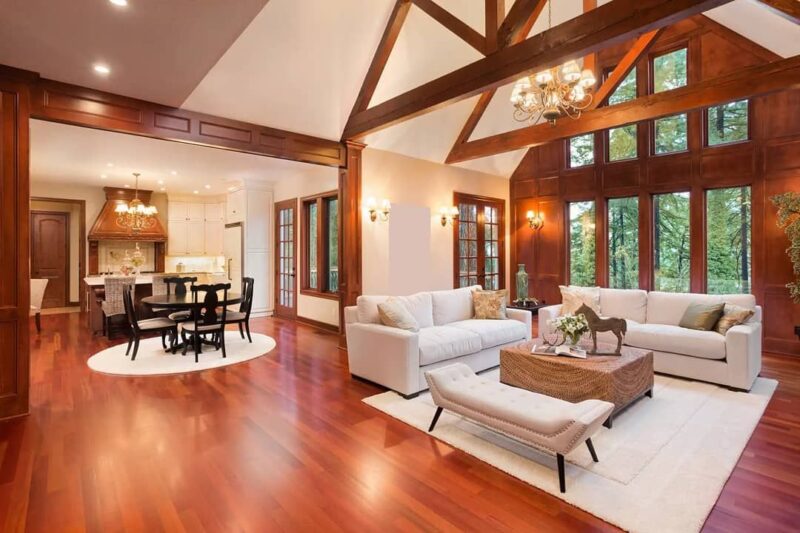For thousands of years of human civilization, timber has been among the most widely present and dominant materials in construction. Without it there would be nothing to support the great demands of our species when it comes to all types of buildings and supporting constructions. Simply put, our society would not be where it is now without trees and the wood it gives us.
For that very reason, and multiple others, timber frame buildings and houses are still largely popular in the 21st century. As with most other things, something that was once obvious, necessary, and common is now rarer and therefor high-end and luxurious.
Houses and buildings that utilize timber for their many elements, especially the frame, are nowadays reserved mostly for construction outside of the very center of the city, like suburbs and countryside. This does not mean that one cannot have a timber frame construction somewhere else of course. If you have a dream to have a wooden frame of your home or workplace, worry not as there are a lot of benefits to it.
While some cons exist as well, overall you should be more than satisfied with the final result. Right here in the article you will find the most important pros and cons of timber frame buildings and houses. In case you wish to learn additional information on this subject, make sure to visit Hamill Creek Timber Frame Homes.
Overview

Source: self-build.co.uk
What is a frame of a building exactly? You may have a general idea but that may not be enough for you especially if you want to have one of your own. A frame is a system of supporting and structural walls, beams, and floors that are basically the whole skeleton of the home. Together with the foundation on the ground, they allow the building to stay up and firmly sit in place no matter what material is put onto it, and what furniture and other elements go inside once everything else is installed and assembled. There are certain scenarios in which wood makes more sense that other elements for the frame, like when ground conditions are poor or when the structural shell has to be built quicker than usually. If there are no large structural spans, you may prefer wood as well.
Pros
Let us start the list with all the positive sides of timber as the ideal material for your home or workplace.
1. Construction Speed
On average, a timber frame for whatever type of building is erected on a construction site considerably faster that the frame of equal strength and supportive power made out of blocks or bricks. What this means is that the whole building process is faster since the electricians and plastering teams can get in and do their respective jobs sooner, as can the rest of the different building specialists and construction workers. The interior is exposed to the outside conditions shorter. What is more, lower temperatures do not halt the process of frame building when timber is used, while blocks and bricks have to wait for more suitable weather conditions.
2. Thermal Isolation

Source: bsssolutions.us
When it comes to thermal performance and isolation from the outside cold, timber does a better job at achieving optimal performance than masonry work. This has to do with the thickness of wood compared to the thinner construction that use bricks, blocks, and mortar. Thermal mass of wood also allows the spaces that have them to heat up quicker and hold the heat while there is a heat source. They will cool off more quickly when the source goes off though.
3. Strength and Appeal
Timber is rather long-lasting, strong, and robust. If properly maintained and cared for, homes that have such framing can last well over 100 years, allowing multiple generations of a family to thrive inside its walls. Not only are they durable, but they look good and allow for so many more design choices and convenient furniture options. Exposed wood is among the fan-favorite interior looks as well.
4. Environmentally Friendly

Source: thenextweb.com
Wood is a renewable source of energy and a green solution when it comes to construction. The more we use it the more we will help the planet recover from the more destructive solutions that require the use of chemicals and burning of fossil fuels to produce. When a tree is cut for timber, another one is planted and the cycle continues, combating global warming in the process.
5. Cost
It depends what kind of home you are aiming for, but wood is generally more expensive to use. However, since it is quicker and more convenient, the overall costs should be lower. While the wood itself will set you back more for sure, you will eventually end up paying for less when it is all set and done and your building is complete.
Cons
Negative sides of wooden frames are less impactful and usually have to do with specific cases rather than the overall cons.
1. Acoustics

Source: pinterest.com
Timber frame deal with the acoustics and noise insulation slightly worse than masonry and concrete. The material is not as dense, meaning the sounds can escape and come in more easily. This can be solved with more wall leaves and structural breaks in-between, filled with sound absorbents.
2. Condensation
Since wood does more poorly against humid and wet conditions, condensation is slightly larger problem than with concrete and mortar. Condensation occurs when cold exterior and warm interior meet during air diffusion. Dew is created and the wood absorbs it. Enough of it over the years, if left unattended, can cause serious molding problems. There are ways around this of course in modern construction.
3. Fire Risks

Source: time.com
Wood burns, everyone knows this. Therefore, timber is at a slightly greater risk of fire but not too great. Since the outer layers turn to charcoal instead of actually burning, the center is protected and will not break that easily. Masonry and steel survive for longer and in higher temperatures however.
4. Infestation and Rot
An even greater danger than condensation and fire when it comes to all sorts of wood is infestation and rot, two issues that usually coincide. As it is happening on the inside, at the very enter of the beams and walls, it is hard to spot until it is too late. Regular maintenance of all wooden elements of your frame is needed to prevent this. Keep moisture around 12%, as 20% moisture is considered very high and the timber will rot. Woodworms and termites are not widely present and there are numerous ways to get rid of them.

